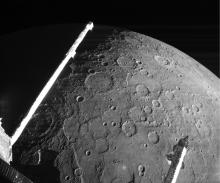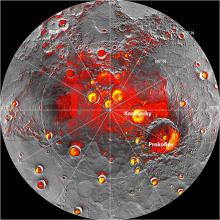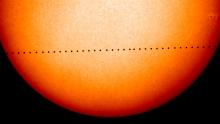Listen to today's episode of StarDate on the web the same day it airs in high-quality streaming audio without any extra ads or announcements. Choose a $8 one-month pass, or listen every day for a year for just $30.
You are here
Mercury in the Evening
The seldom-seen planet Mercury is putting in a pretty decent appearance in the early evening sky right now. It’s quite low as twilight begins to fade away, a little to the north of due west. It looks like a moderately bright star, well to the lower right of brilliant Venus, the “evening star.”
Mercury is closer to the Sun than any other planet. From our perspective here on Earth, that means it never moves far away from the Sun. At best, it’s visible for a little while after sunset or before sunrise. So while it’s usually pretty bright, it’s so low in the sky, and so often immersed in the glow of twilight, that it’s easy to miss or overlook.
Because Mercury is so close to the Sun, it’s quite hot. But a few spots are icy cold. In fact, they may be filled with ice. And a recent study found some icy spots that no one had noticed before.
The spots are at the bottoms of craters at Mercury’s poles. They never see the Sun, so they stay quite cold, allowing ice to build up. And using observations from a spacecraft that orbited Mercury, scientists recently found three more ice-filled craters. The ice in these craters alone could cover more than a thousand square miles.
The study also found smaller amounts of ice outside those craters, in small wrinkles and depressions where sunlight is also rare. If people ever live on Mercury, that ice -- big deposits and small -- could provide a handy resource on the Sun’s closest planet.





